Short Takeoff and Landing Strategy for Small-Scale Thrust-Vectoring Vertical/Short Takeoff and Landing Vehicles
Abstract
:1. Introduction
- A brief introduction of the studied F-35B platform, especially its propulsion system and the flight dynamics model for it.
- Performance analyses of the studied F-35B platform based on the flight dynamics model.
- The design of the STO and SRVL strategy based on the performance analysis results and the NDI-based control system supporting the strategy execution.
- The simulation of the whole system to verify the strategy design and the conclusion based on the simulation results.
2. The Platform Modeling
2.1. The Propulsion System
2.2. The Flight Dynamics Model
3. Performance Analysis
3.1. Short Takeoff Performance
3.2. Landing Performance
3.3. Deceleration Performance
3.4. Trajectory Stability
3.5. Velocity Stability
3.6. Transition Corridor
4. The STO Strategy
- Stage I: Taxiing
- 2.
- Stage Ⅱ: Liftoff
- 3.
- Stage Ⅲ: Takeoff
5. The SRVL Strategy
- Stage I: Descending and deceleration
- 2.
- Stage II: Stability Adjustment
- 3.
- Stage III: Touchdown preparation
6. The Controller Design
6.1. The Outer-Loop Design
6.2. The Inner-Loop Design
6.3. The Allocator Design
7. The Simulation
7.1. The Nominal State Simulation
7.2. The Perturbation Simulation
8. Conclusions
- The STO and SRVL strategy should be designed on the basis of specific references. The mission references should consider the specific performance of the aircraft, such as takeoff/landing performance, deceleration performance, speed stability, and trajectory stability. The AES method is a model-based solution for strategy formation.
- The Monte-Carlo simulations verified the robustness performance of the piecewise control structure. The results show that the strategy satisfies the mission requirements and has strong robustness.
- The touchdown state of thrust-vectoring V/STOL can be ensured by the SRVL strategy. The velocity states are decoupled from the overall longitudinal states by entering the stable velocity regions with the attitude states controlled.
Author Contributions
Funding
Institutional Review Board Statement
Informed Consent Statement
Data Availability Statement
Conflicts of Interest
References
- Britt, R.T.; Arthurs, T.D.; Jacobson, S.B. Aeroservoelastic analysis of the B-2 bomber. J. Aircr. 2000, 37, 745–752. [Google Scholar] [CrossRef]
- Jacobson, S.; Britt, R.; Freim, D.; Kelly, P. Residual pitch oscillation (rpo) flight test and analysis on the b-2 bomber. ICES J. Mar. Sci. 2003, 67, 1260–1271. [Google Scholar] [CrossRef]
- Su, W.; Gao, Z.H.; Xia, L. Multiobjective optimization design of aerodynamic configuration constrained by stealth performance. Acta Aerodyn. Sin. 2006, 24, 137–140. [Google Scholar] [CrossRef]
- Ransone, R. An Overview of Experimental VSTOL Aircraft and Their Contributions. AIAA 2002, 64, 1–21. [Google Scholar] [CrossRef]
- Parsons, D.G.; Levin, D.E.; Panteny, D.J.; Wilson, P.N.; Rask, M.R.; Morris, B.L. F-35 STOVL Performance Requirements Verification. In The F-35 Lightning II: From Concept to Cockpit; American Institute of Aeronautics and Astronautics: Reston, VA, USA, 2022; pp. 641–680. [Google Scholar] [CrossRef]
- Goman, M.G.; Khramtsovsky, A.V.; Kolesnikov, E.N. Evaluation of Aircraft Performance and Maneuverability by Computation of Attainable Equilibrium Sets. J. Guid. Control. Dyn. 2008, 31, 329–339. [Google Scholar] [CrossRef]
- Walker, G.; Allen, D. X-35B STOVL Flight Control Law Design and Flying Qualities. In Proceedings of the 2002 Biennial International Powered Lift Conference and Exhibit, Williamsburg, VA, USA, 5–7 November 2002; pp. 1–13. [Google Scholar] [CrossRef]
- Osder, S.; Caldwell, D. Design and robustness issues for highly augmented helicopter controls. J. Guid. Control. Dyn. 1992, 15, 1375–1380. [Google Scholar] [CrossRef]
- Carter, J.; Stoliker, P. Flying quality analysis of a JAS 39 Gripen ministick controller in an F/A-18 aircraft. In Proceedings of the AIAA Guidance, Navigation, and Control Conference and Exhibit, Dever, CO, USA, 14–17 August 2000; pp. 1–20. [Google Scholar] [CrossRef] [Green Version]
- Denham, J. STOVL Integrated Flight and Propulsion Control: Current Successes and Remaining Challenges. In Proceedings of the 2002 Biennial International Powered Lift Conference and Exhibit, Williamsburg, VA, USA, 5–7 November 2002. [Google Scholar] [CrossRef]
- Xili, Y.; Yong, F.; Jihong, Z. Transition Flight Control of Two Vertical/Short Takeoff and Landing Aircraft. J. Guid. Control. Dyn. 2008, 31, 371–385. [Google Scholar] [CrossRef]
- Zian, W.; Shengchen, M.; Zheng, G. Energy Efficiency Enhanced Landing Strategy for Manned eVTOLs Using L1 Adaptive Control. Symmetry 2021, 13, 2125. [Google Scholar] [CrossRef]
- Cao, C.; Hovakimyan, N. Design and Analysis of a Novel L1 Adaptive Controller, Part I: Control Signal and Asymptotic Stability. In Proceedings of the 2006 American Control Conference, Minneapolis, MN, USA, 14–16 June 2006. [Google Scholar] [CrossRef]
- Liu, N.; Cai, Z.; Wang, Y. Fast level-flight to hover mode transition and altitude control in tiltrotor’s landing operation. Chin. J. Aeronaut. 2020, 34, 181–193. [Google Scholar] [CrossRef]
- AIAA. Control configuration design for a mixed vectored thrust ASTOVL aircraft in hover–Navigation and Control Conference (AIAA). Adv. Mater. 2009, 21, 4880–4910. [Google Scholar] [CrossRef]
- Yang, Z.F.; Lei, H.M.; Li, Q.L.; Li, J. A missile control system design approach based on dynamic inverse and robust trajectory tracking control. Yuhang Xuebao/J. Astronaut. 2011, 32, 317–322. [Google Scholar]
- Toha, S.F.; Tokhi, M.O. Dynamic Nonlinear Inverse-Model Based Control of a Twin Rotor System Using Adaptive Neuro-fuzzy Inference System. In Proceedings of the Third Uksim European Symposium on Computer Modeling & Simulation IEEE Computer Society, Athens, Greece, 25–27 November 2009. [Google Scholar] [CrossRef]
- Fan, Z.Q.; Fang, Z.P. Robust, nonlinear control design for a post-stall maneuver aircraft. Acta Aeronaut. Et Astronaut. Sin. 2002, 23, 193–196. [Google Scholar] [CrossRef]
- Bodson, M. Evaluation of optimization methods for control allocation. J. Guid. Control. Dyn. 2002, 25, 703–711. [Google Scholar] [CrossRef]
- Burken, J.; Lu, P.; Wu, Z.; Bahm, C. Two reconfigurable flight-control design methods: Robust servomechanism and control allocation. J. Guid. Control. Dyn. 2012, 24, 482–493. [Google Scholar] [CrossRef] [Green Version]
- Falkena, W.; Borst, C.; Chu, Q.P.; Mulder, J.A. Investigation of Practical Flight Envelope Protection Systems for Small Aircraft. AIAA Guid. Navig. Control. Conf. 2011, 34, 976–988. [Google Scholar] [CrossRef] [Green Version]
- Yu, Z.; Li, Y.; Zhang, Z.; Xu, W.; Dong, Z. Online safe flight envelope protection for icing aircraft based on reachability analysis. Int. J. Aeronaut. Space Sci. 2020, 21, 1174–1184. [Google Scholar] [CrossRef]
- Lombaerts, T.; Schuet, S.; Acosta, D.; Kaneshige, J.; Shish, K.; Martin, L. Piloted simulator evaluation of safe flight envelope display indicators for loss of control avoidance. J. Guid. Control. Dyn. 2016, 40, 948–963. [Google Scholar] [CrossRef]
- Cheng, Z.; Zhu, J.; Yuan, X. Design of optimal trajectory transition controller for thrust-vectored V/STOL aircraft. Sci. China Inf. Sci. 2021, 64, 139201. [Google Scholar] [CrossRef]
- Aguiar, A.P.; Hespanha, J.P. Trajectory-tracking and path-following of underactuated autonomous vehicles with parametric modeling uncertainty. IEEE Trans. Autom. Control. 2007, 52, 1362–1379. [Google Scholar] [CrossRef] [Green Version]
- Chunzhe, Z.; Yi, H. ADRC Based Integrated Guidance and Control Scheme for the Interception of Maneuvering Targets with Desired LOS Angle. In Proceedings of the 29th China Control Conference, Beijing, China, 29 July 2010; ISBN 978-7-8946-3104-6. [Google Scholar]
- Shakarian, A. Application of Monte-Carlo Techniques to the 757/767 Autoland Dispersion Analysis by Simulation. Guid. Control. Conf. 1983, 83, 181–194. [Google Scholar] [CrossRef]
- Williams, P. A Monte Carlo dispersion analysis of the X-33 simulation software. In Proceedings of the AIAA Atmospheric Flight Mechanics Conference and Exhibit, Montreal, QC, Canada, 6–9 August 2001. [Google Scholar] [CrossRef] [Green Version]
- Chao, Z.; Lei, C.; Zongji, C. Monte Carlo Simulation for Vision-based Autonomous Landing of Unmanned Combat Aerial Vehicles. J. Syst. Simul. 2010, 22, 2235–2240. [Google Scholar] [CrossRef]
- The Pla General Armament Department. Gjb 3719-99; Ship-Based Airplane Specification (Flying Qualities) [S]; The PLA General Armament Department: Beijing, China, 1999; pp. 16–19. [Google Scholar]
- Ding, Y. Study on Ducted Vertical Take-Off and Landing Fixed-Wing UAV Dynamics Modeling and Transition Corridor. Appl. Sci. 2021, 11, 10422. [Google Scholar] [CrossRef]

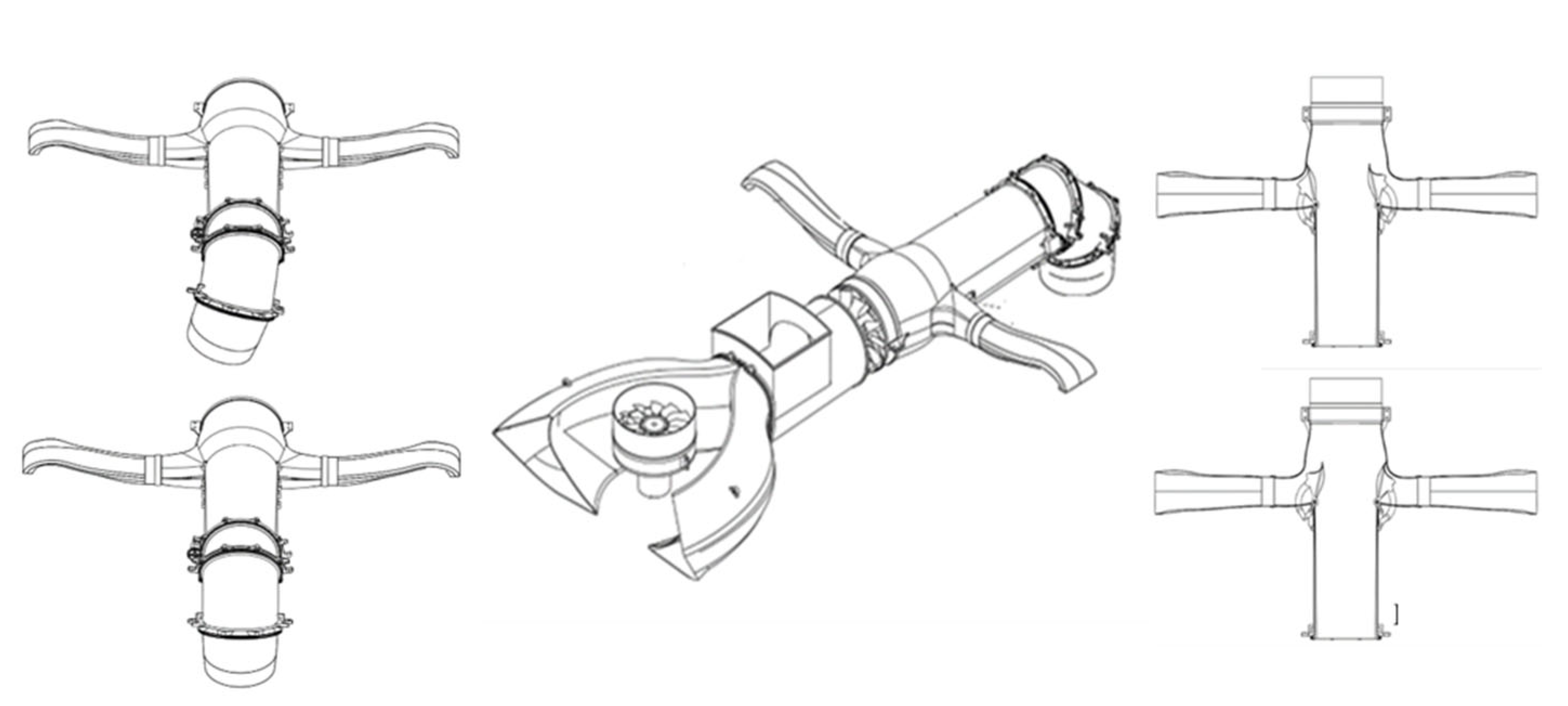
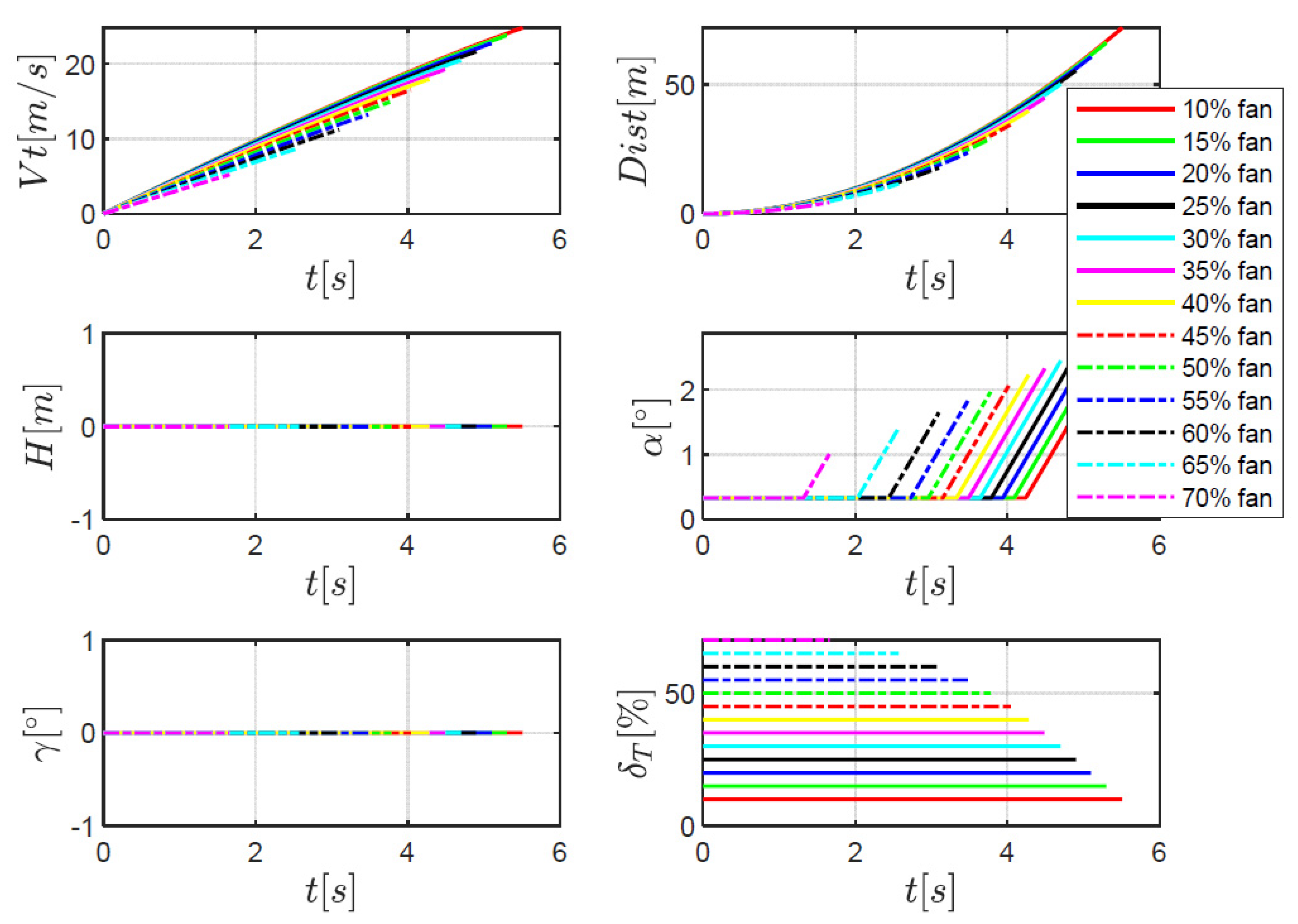
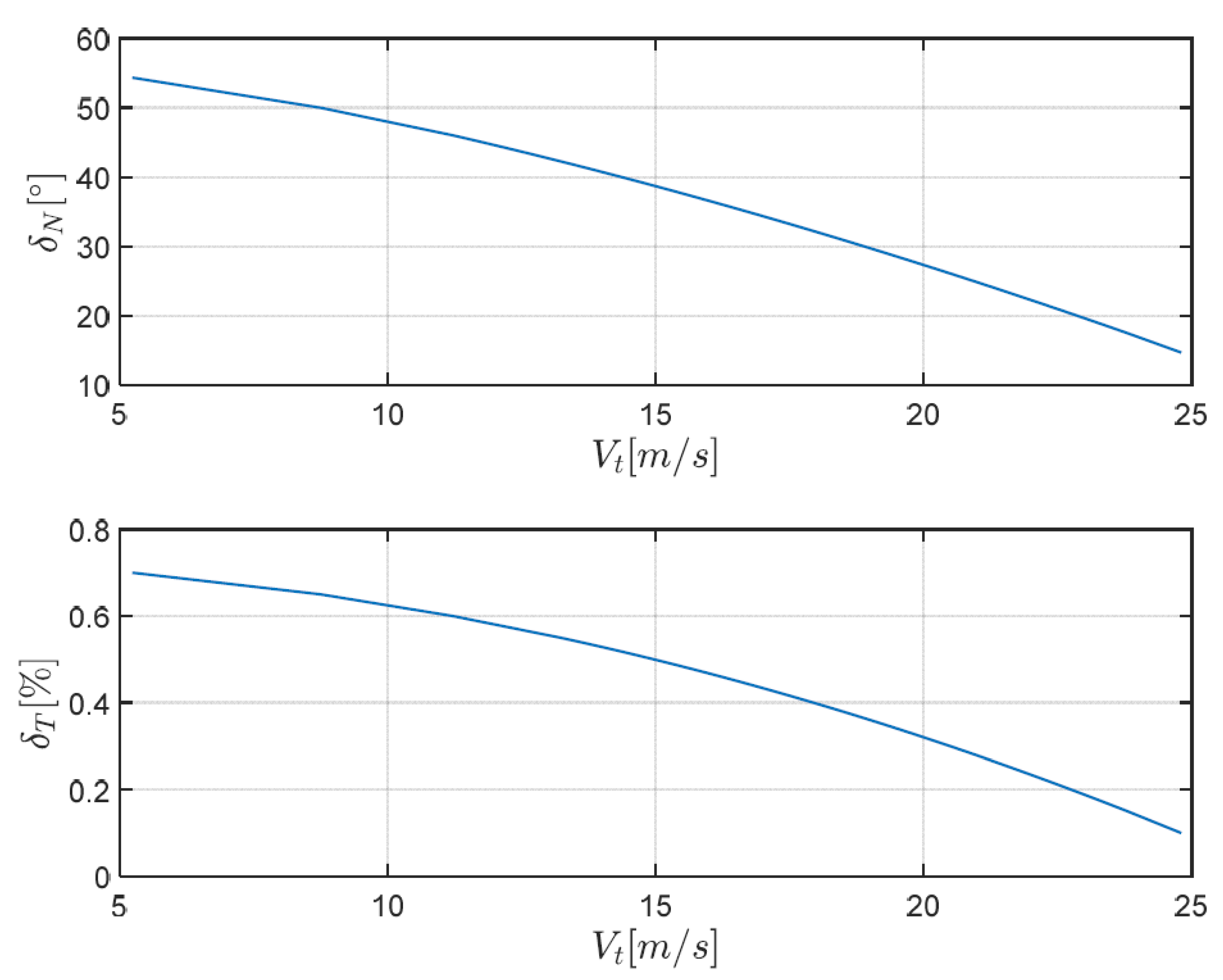
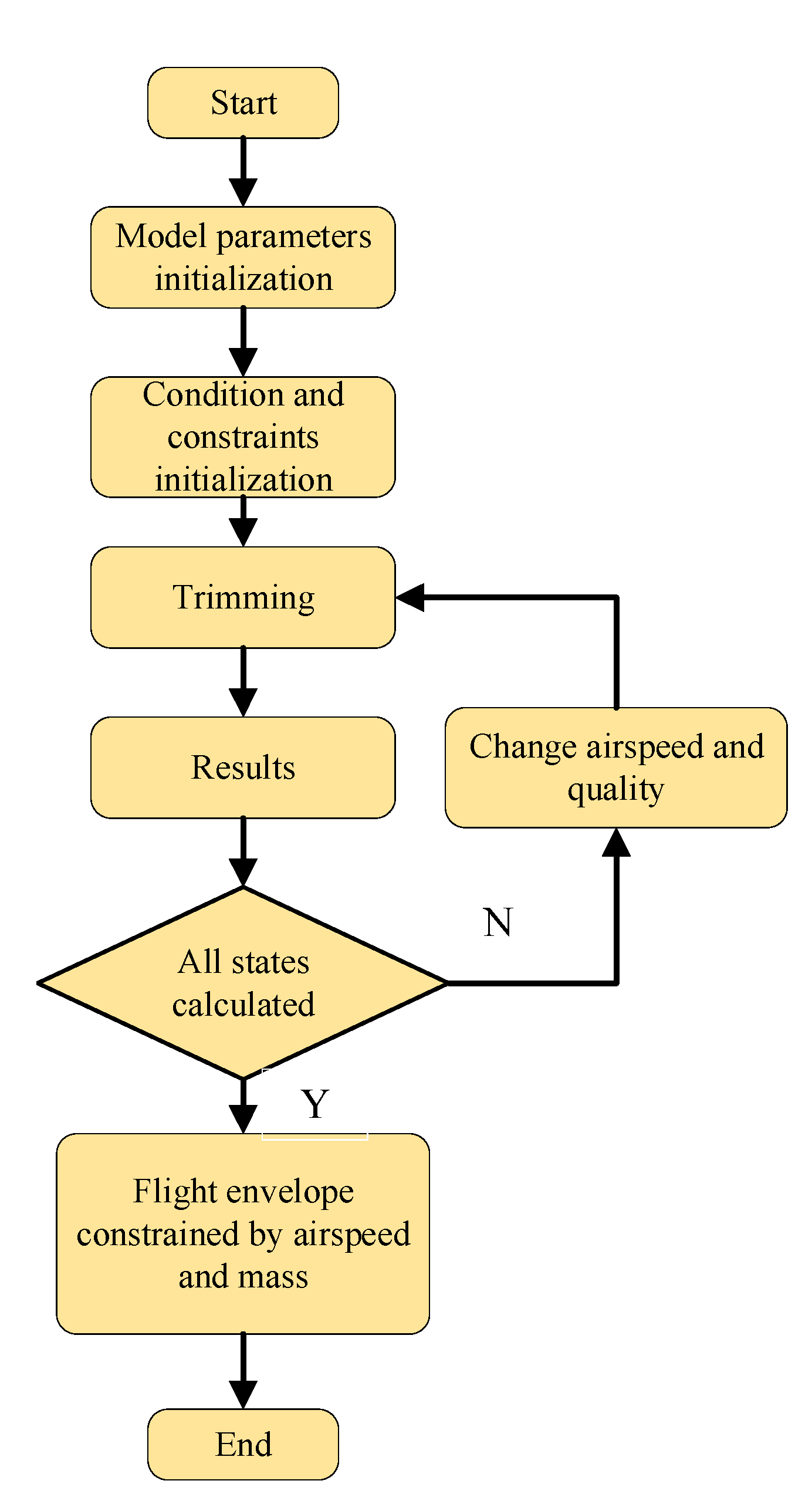
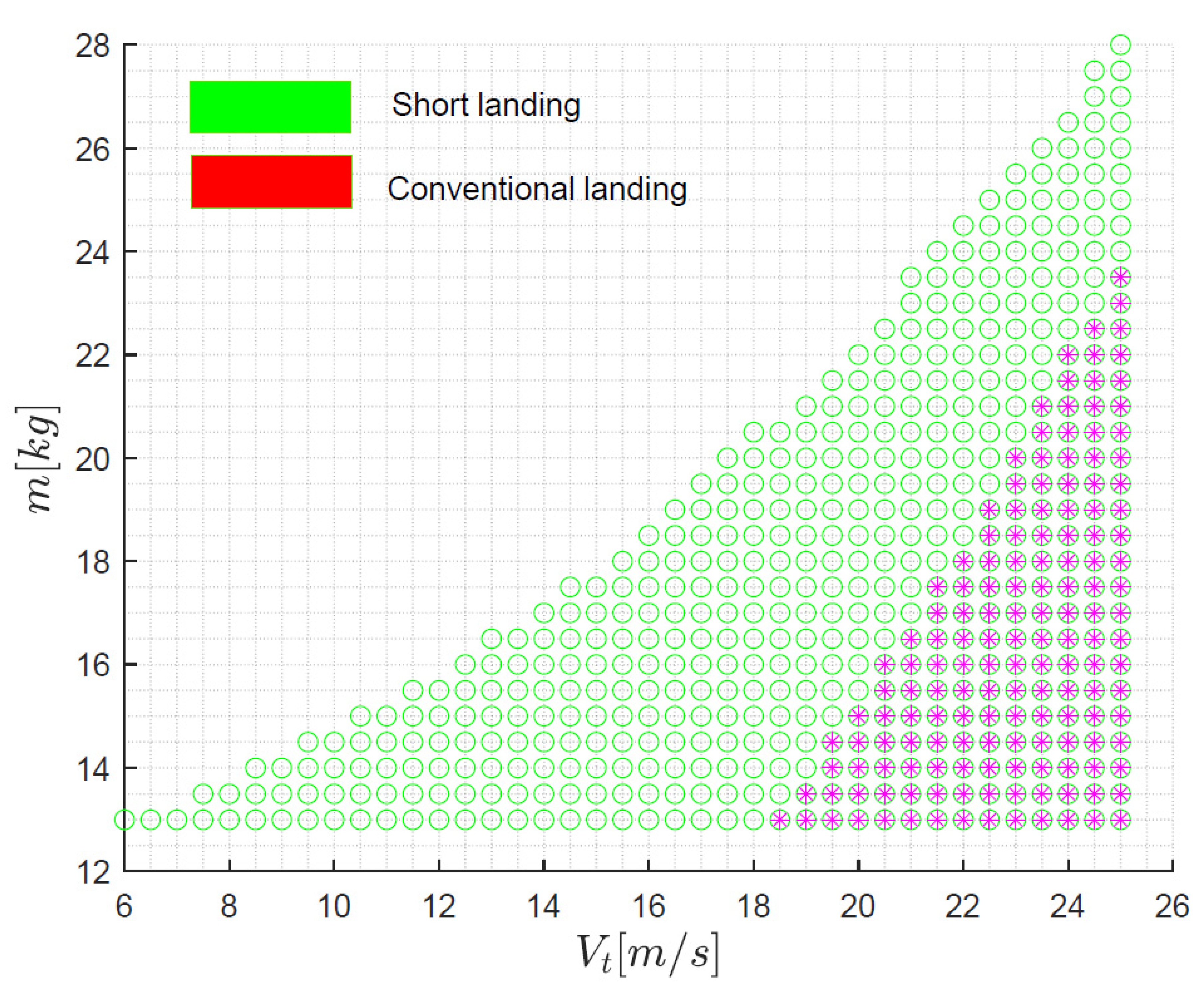
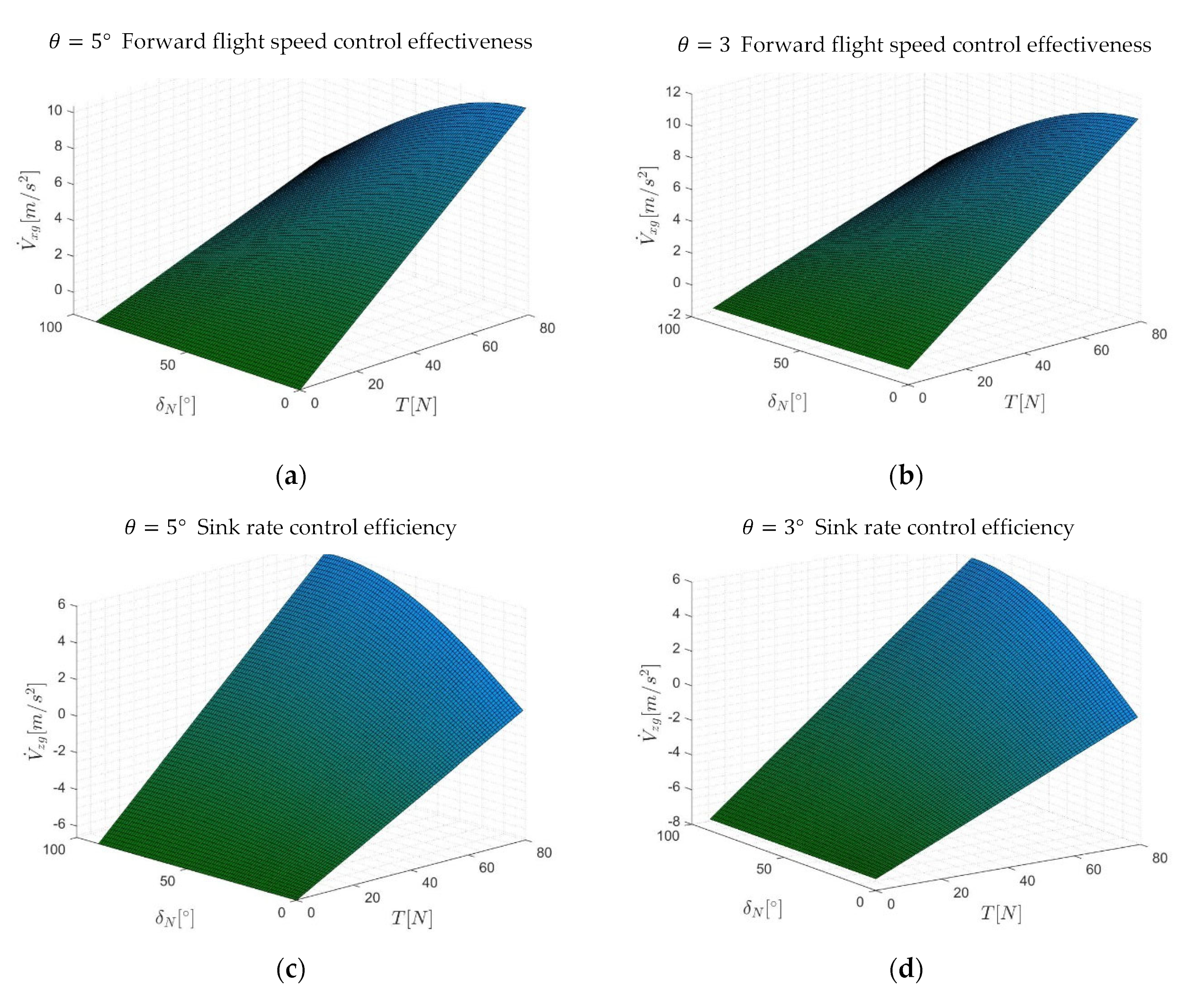
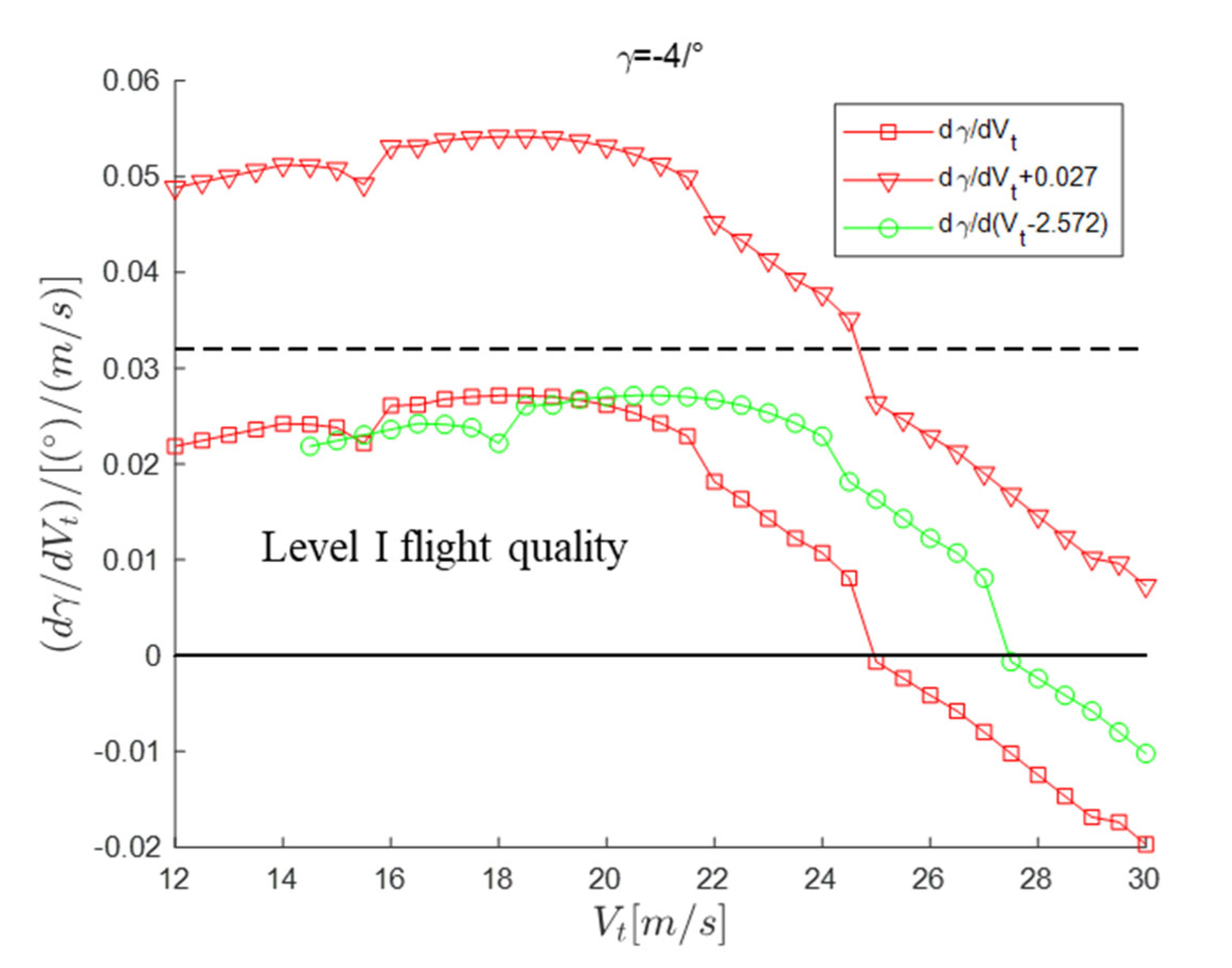
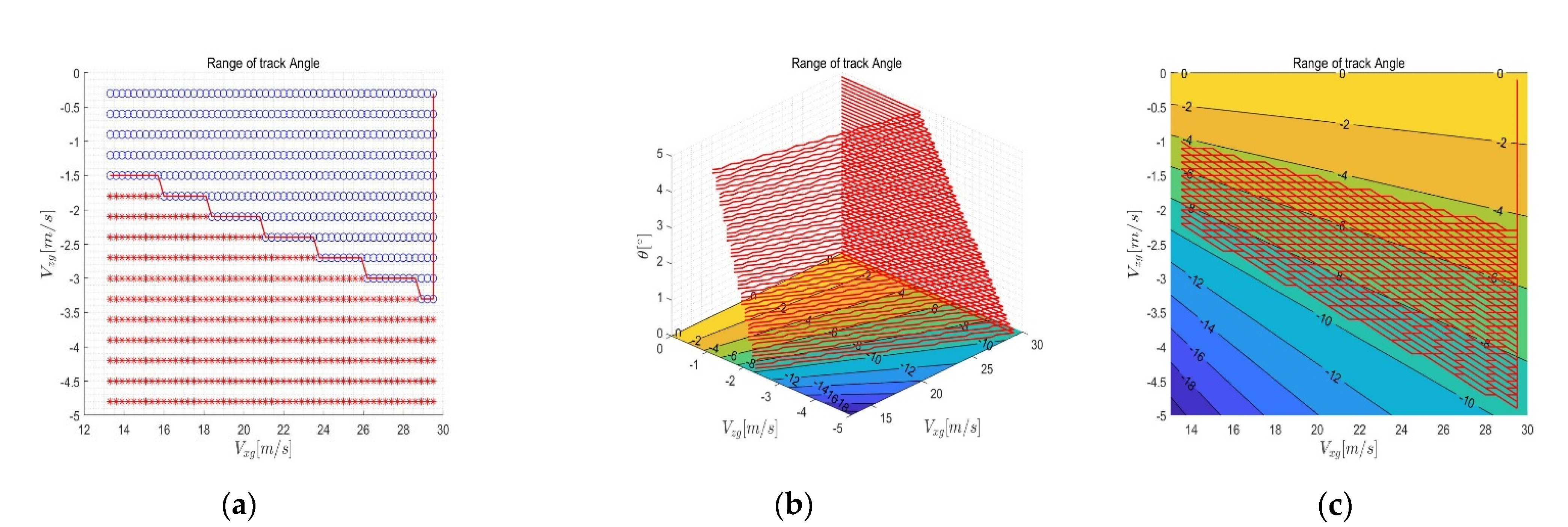
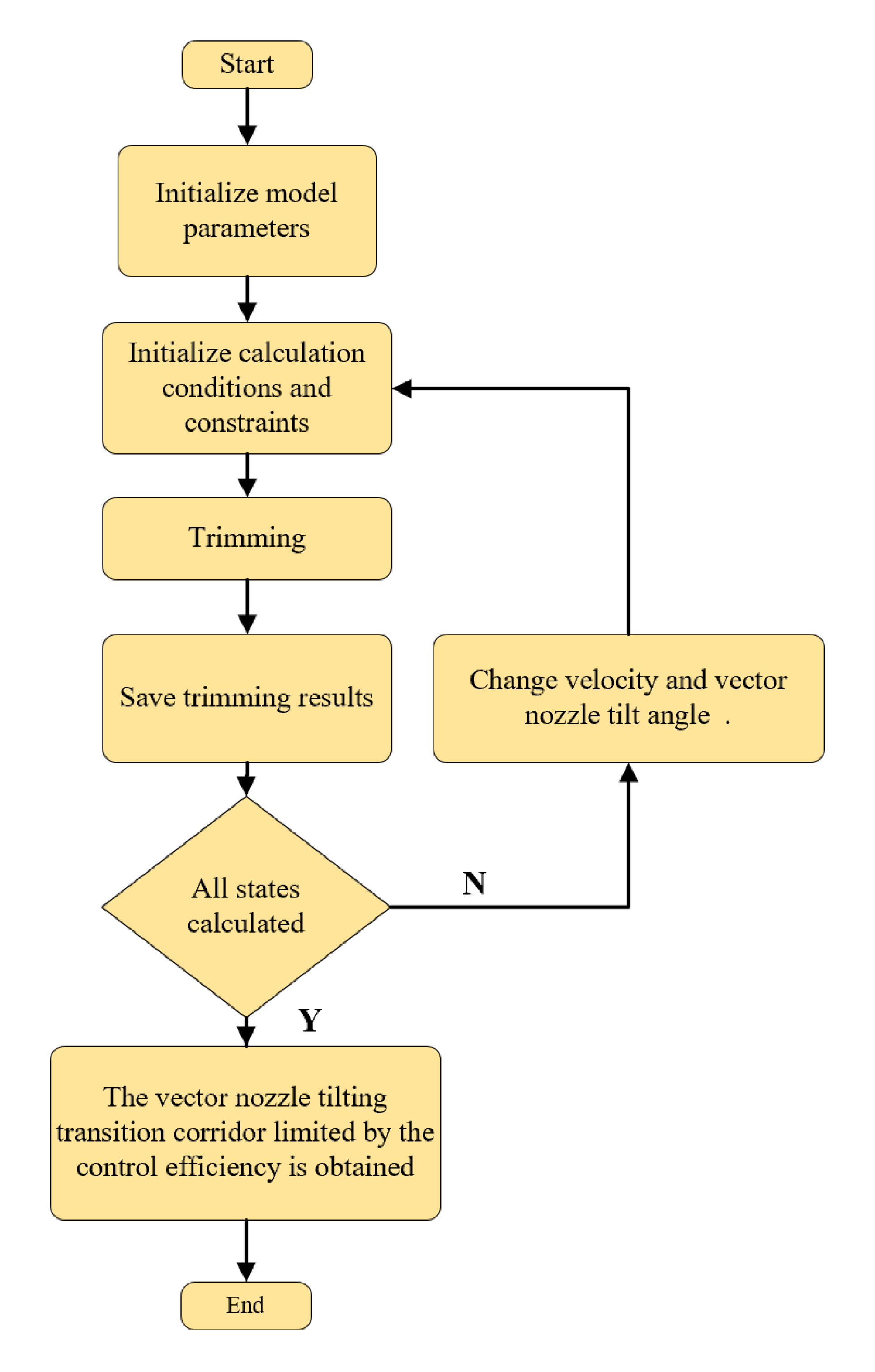
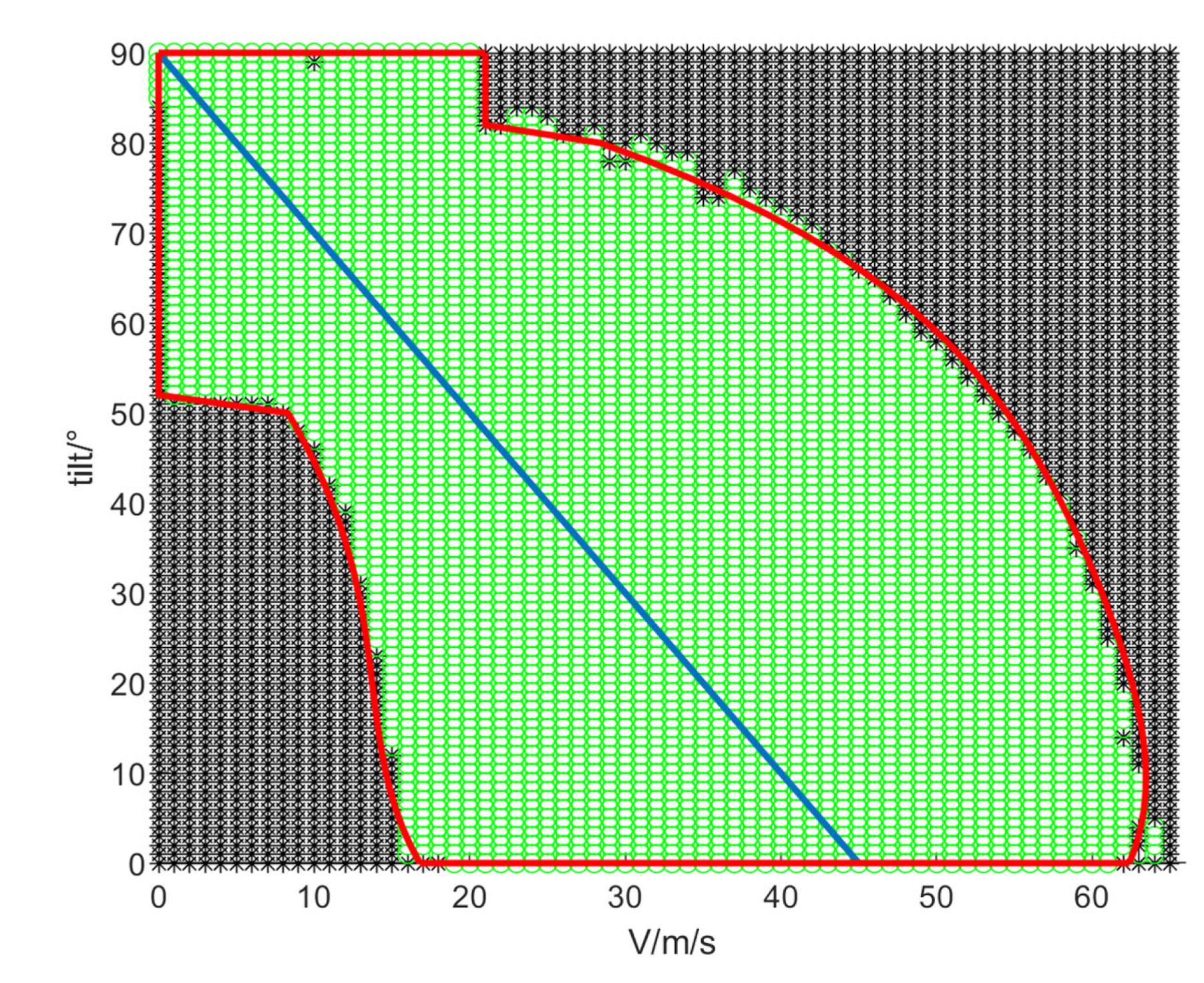

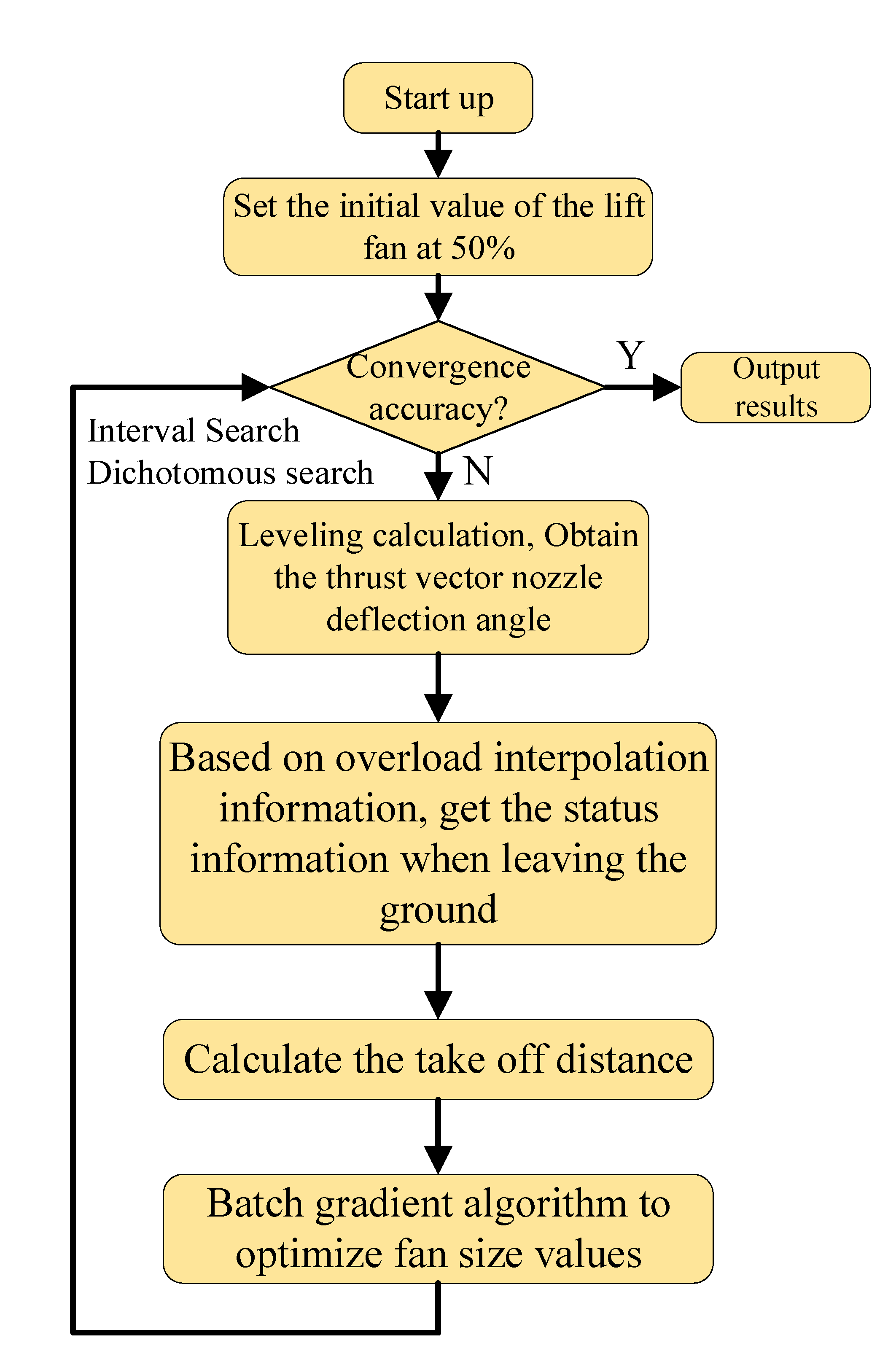


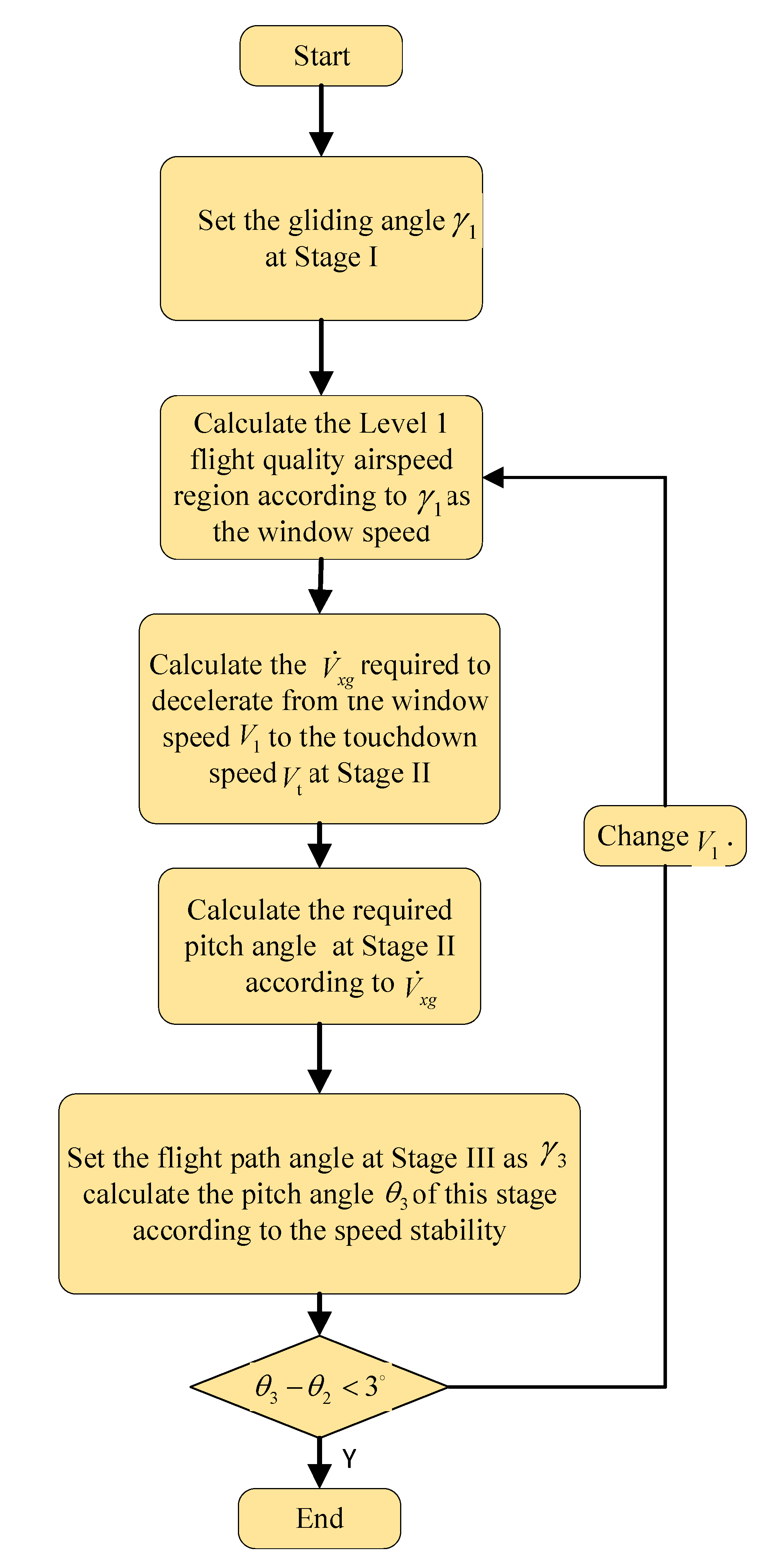
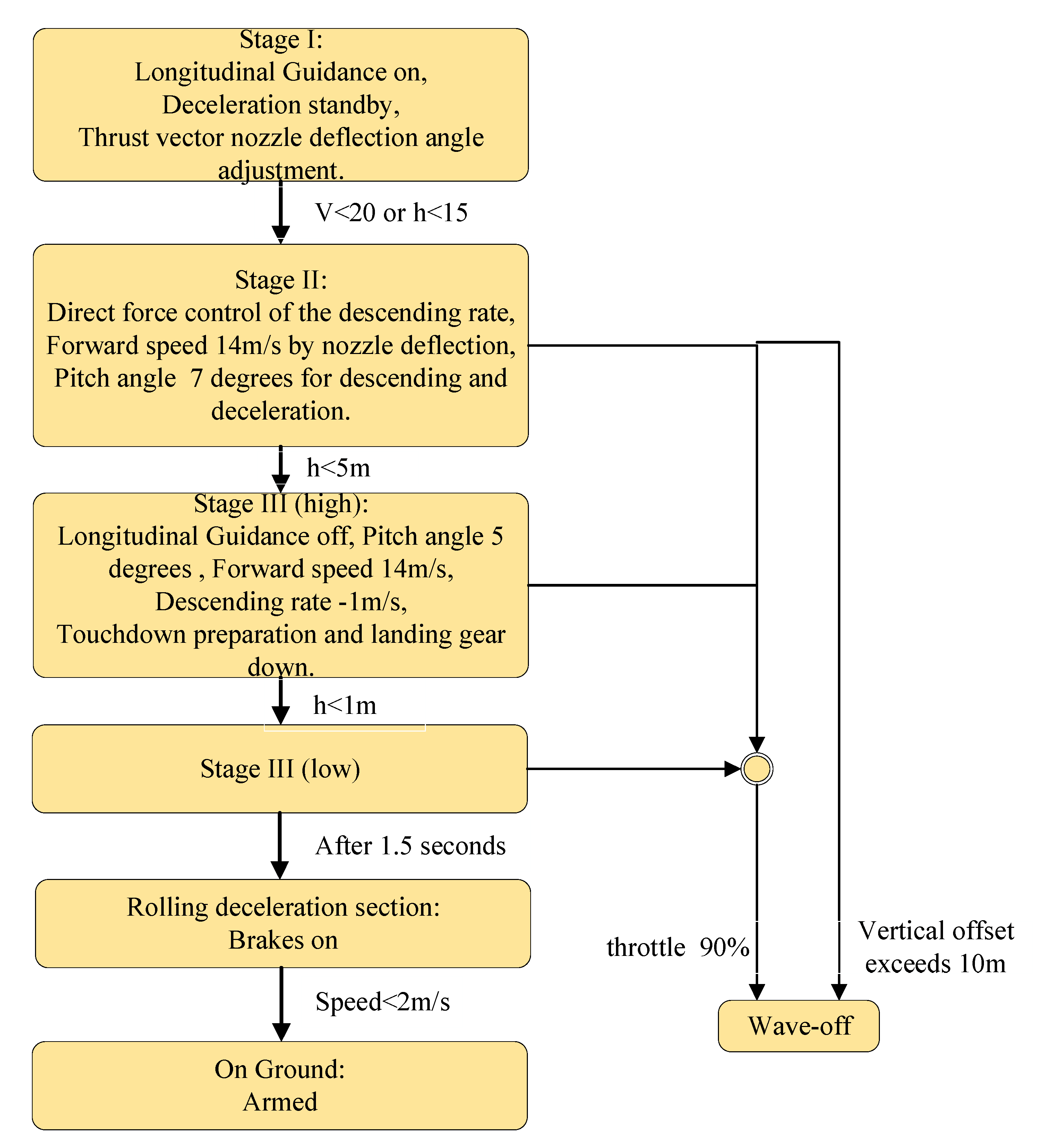

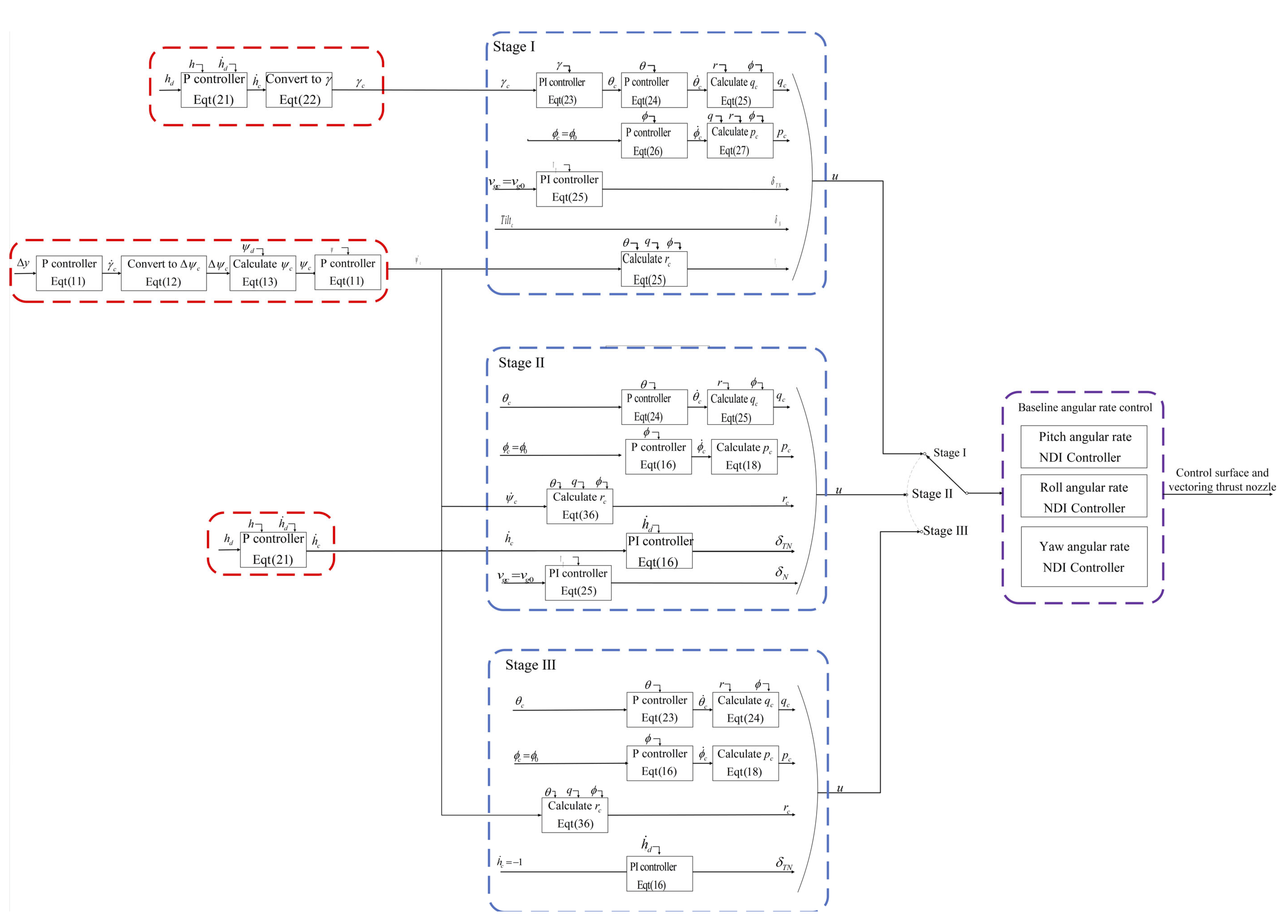
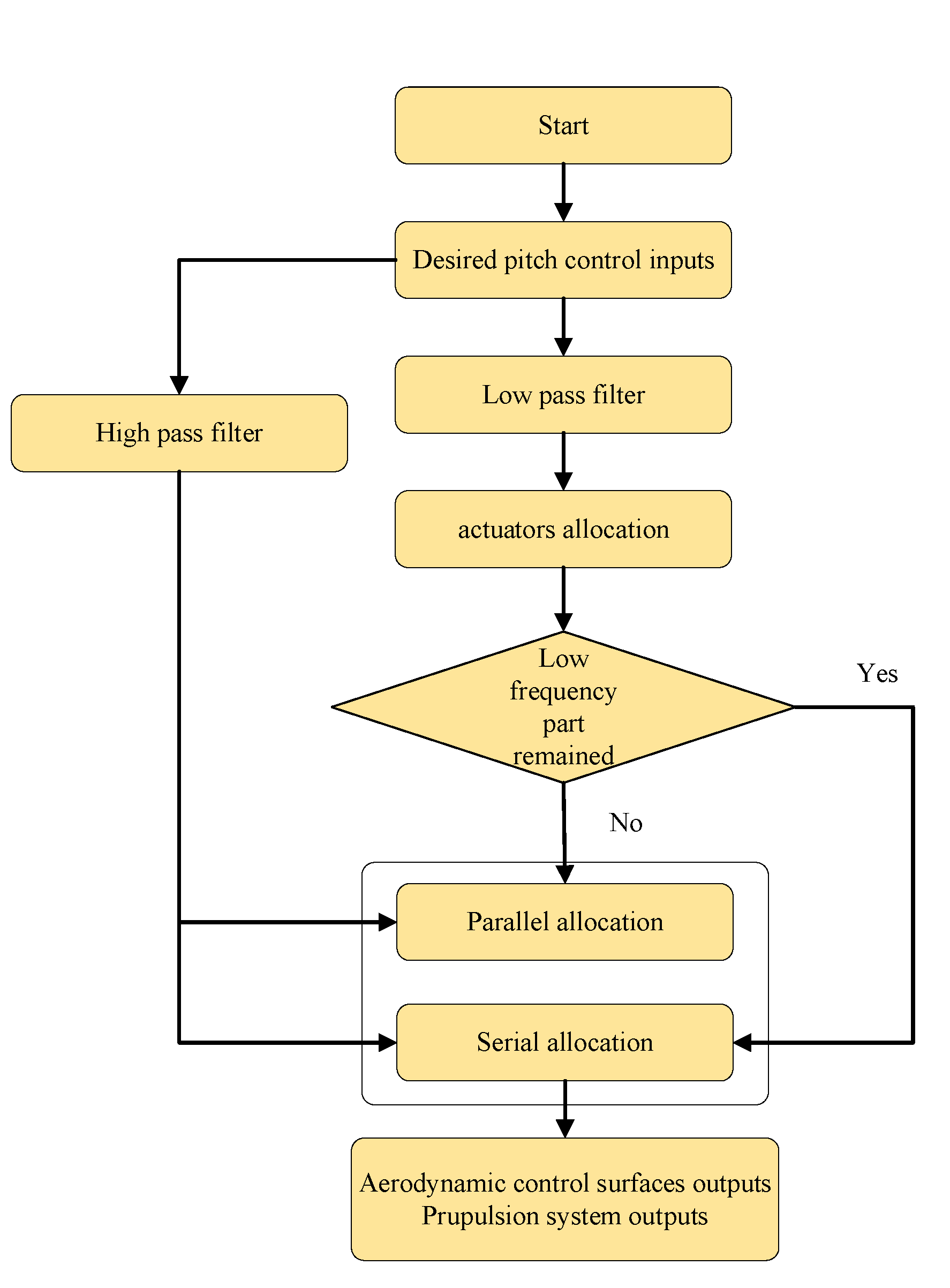
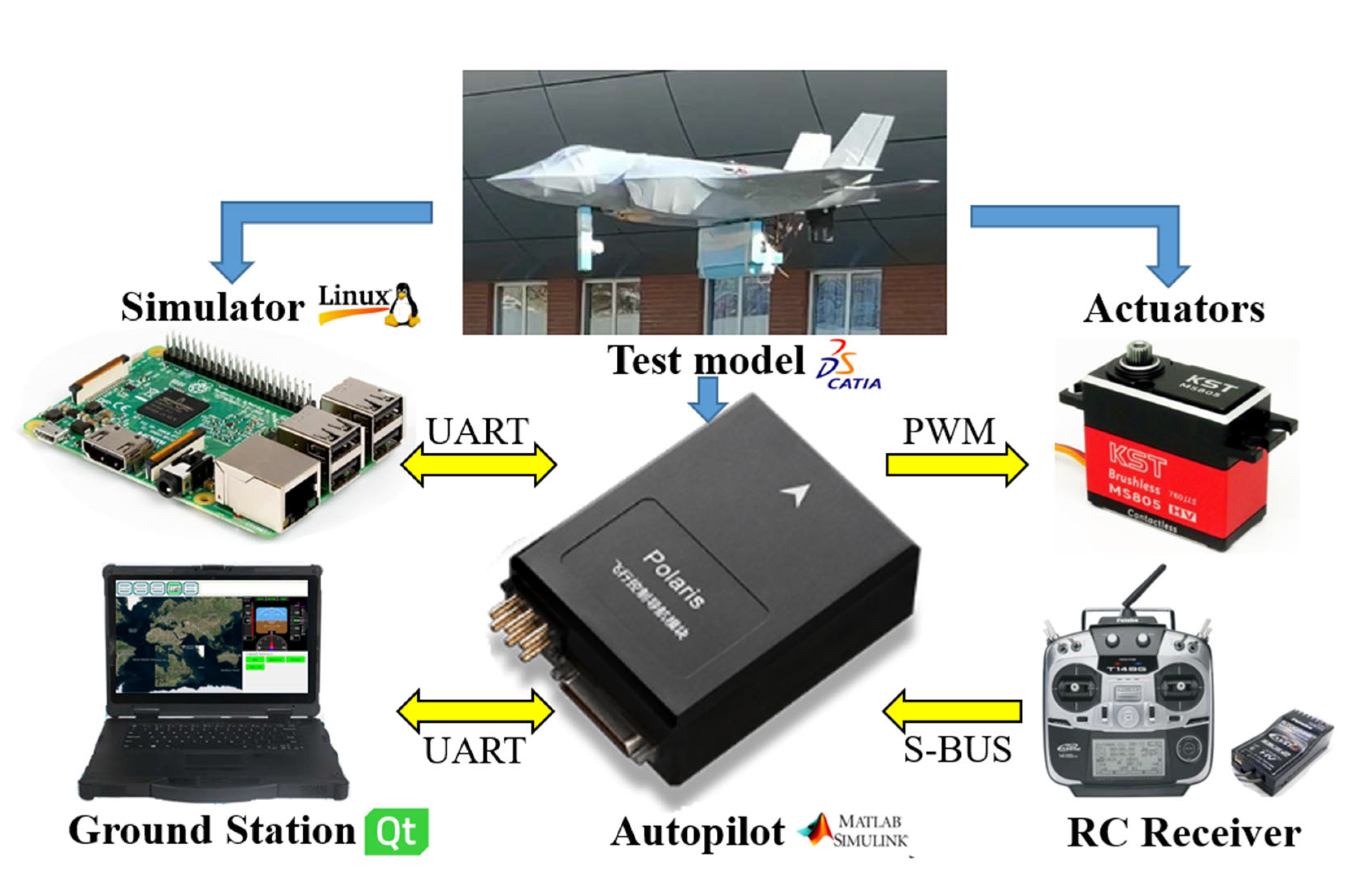
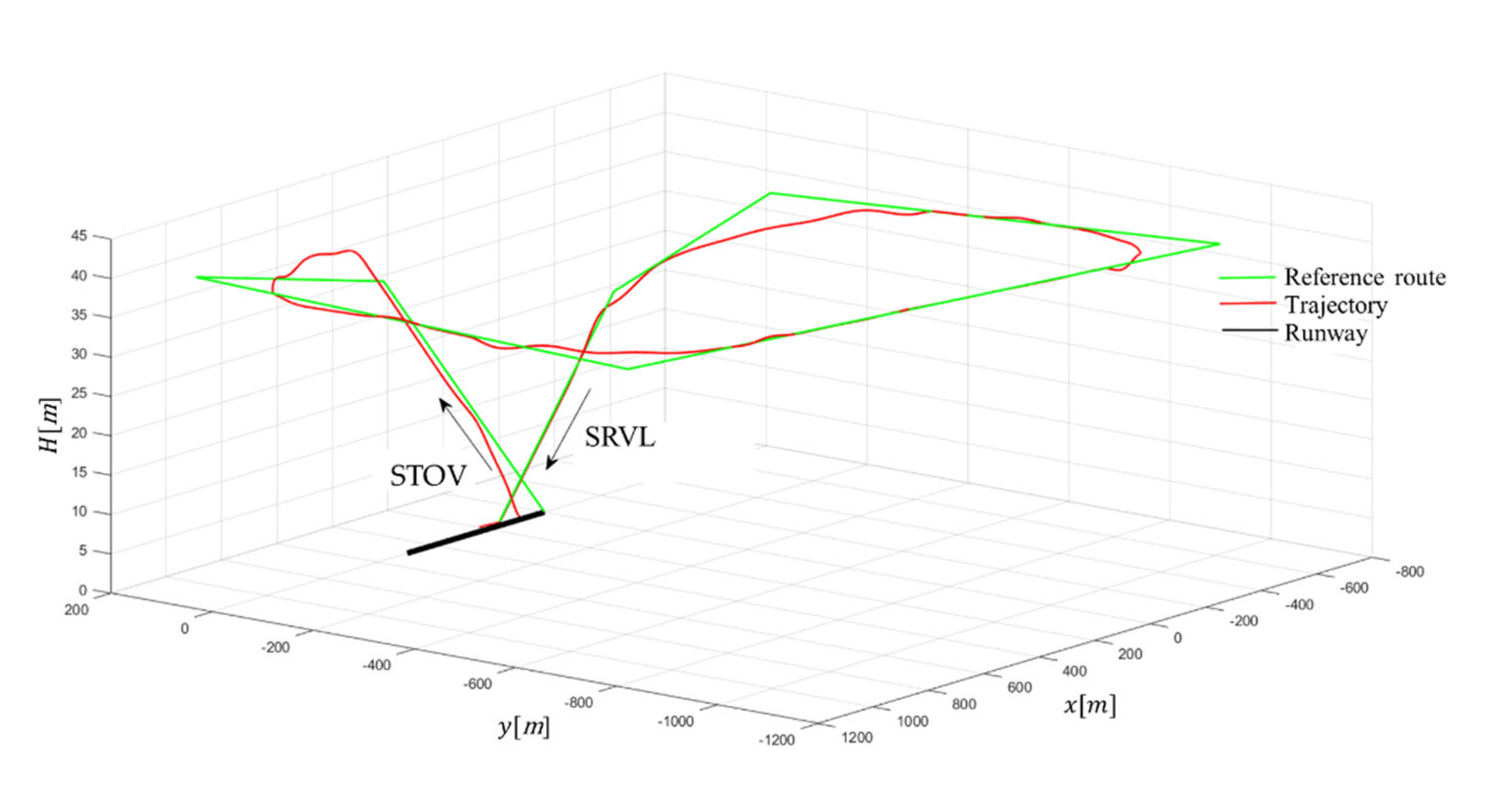
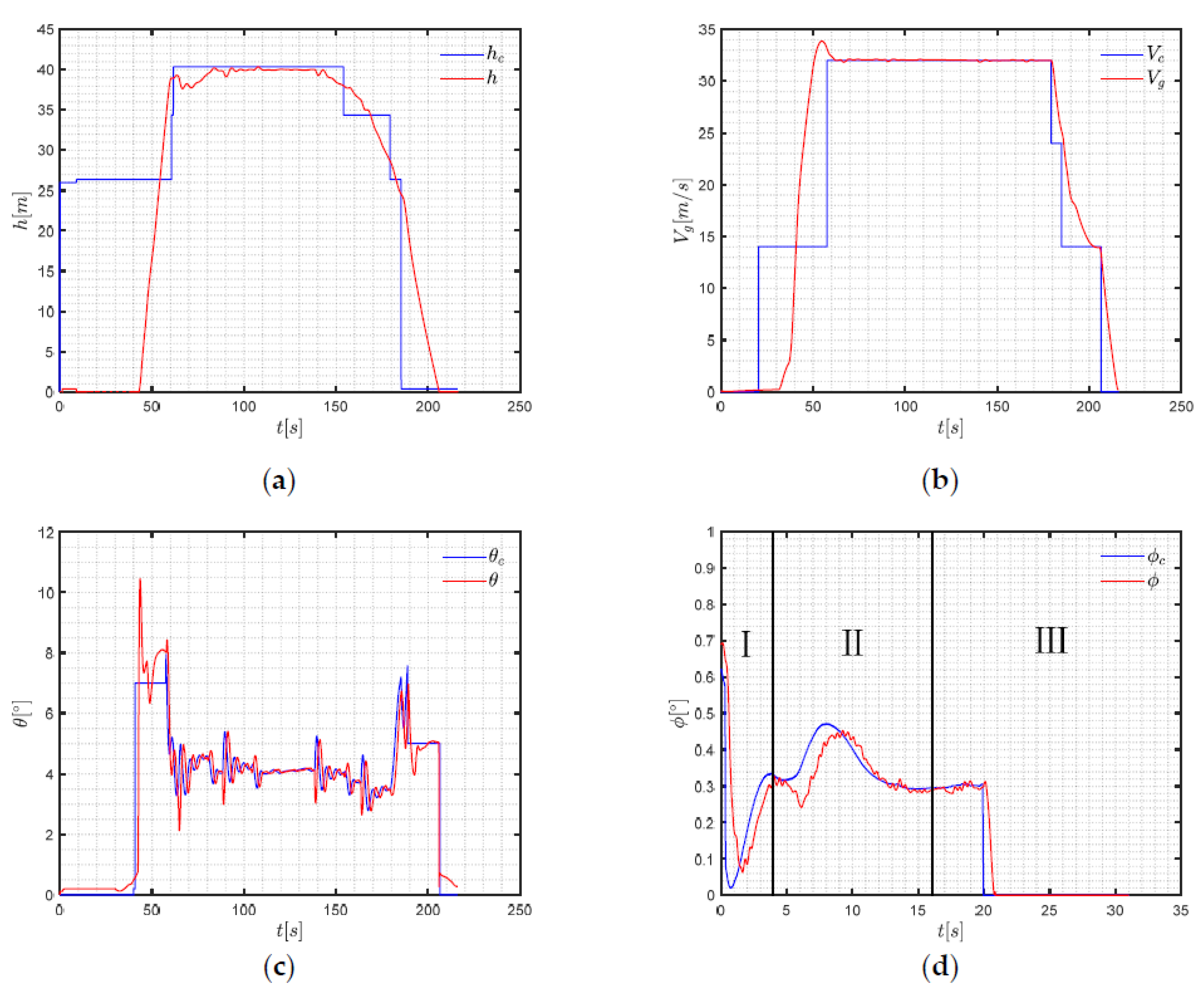
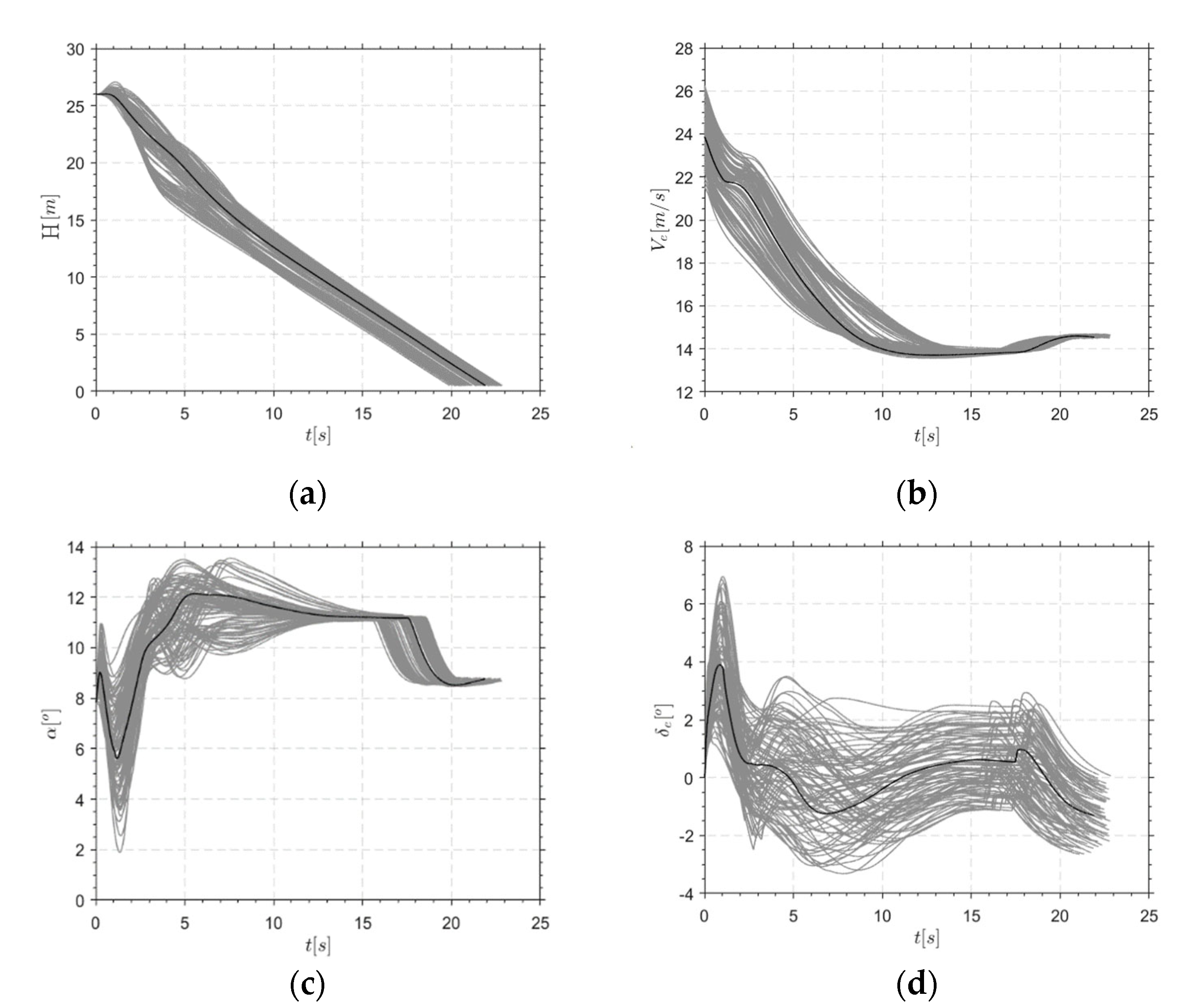
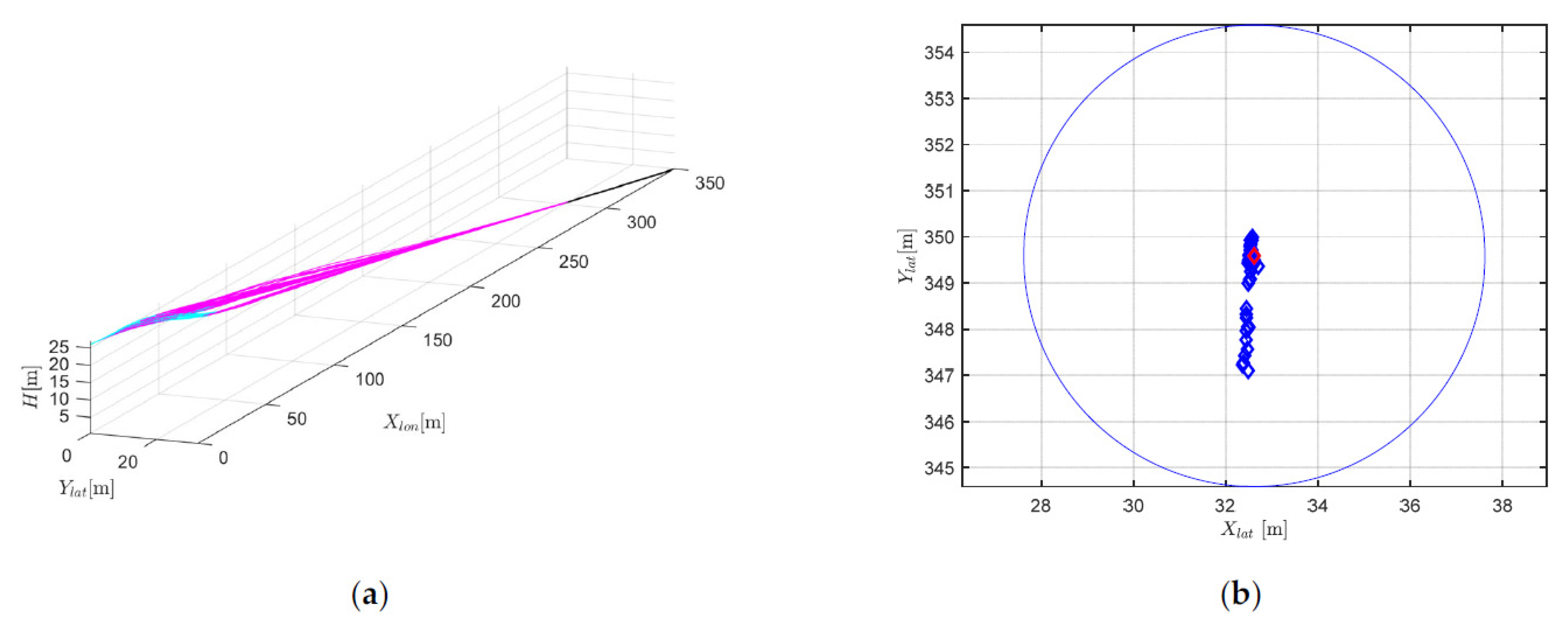
| Parameters | Value | Parameters | Value |
|---|---|---|---|
| Mass | Reference area | ||
| Cruise speed | 30 m/s | Wing span | 1.53 m |
| Cruise altitude | <100 m | Flight endurance | 6 min |
| Physical Quantities | Value | Value | Value | Value | Value |
|---|---|---|---|---|---|
| Lift fan thrust (%) | 30% | 40% | 50% | 60% | 70% |
| Taxi time (s) | 4.7 | 4.49 | 4.28 | 4.04 | 3.78 |
| Taxi distance (m) | 50.14 | 39.80 | 29.11 | 17.79 | 4.40 |
| Liftoff speed (m/s) | 20.48 | 17.94 | 14.96 | 11.212 | 5.228 |
| Tilt angle (deg) | 26.10 | 32.22 | 38.77 | 45.99 | 54.33 |
| Actuators | Max Value |
|---|---|
| [−35°, 35°] | |
| [0, 80N] | |
| [0, 80N] | |
| [0, 90°] |
| Parameters | Values |
|---|---|
| Parameters | Ranges |
|---|---|
| The slope of the lift curve | |
| Side force control derivatives | |
| Cross roll control derivatives | |
| Pitch control derivatives | |
| Yaw control derivatives | |
| Yaw damping derivatives | |
| Center of gravity in the x-axis | |
| Inertia moment around the y-axis | |
| Lift control derivatives | |
| Roll stability derivatives | |
| Roll damping derivatives | |
| Pitch damping derivatives | |
| Cross yaw control derivatives | |
| Drag control derivatives | |
| Pitch stability derivatives | |
| Inertia moments around the z-axis | |
| Side force stability derivatives | |
| Roll control derivatives | |
| Cross roll damping derivatives | |
| Cross yaw damping derivatives | |
| Yaw stability derivatives | |
| Thrust coefficients of lift fan | |
| Inertia moments around the x-axis |
Publisher’s Note: MDPI stays neutral with regard to jurisdictional claims in published maps and institutional affiliations. |
© 2022 by the authors. Licensee MDPI, Basel, Switzerland. This article is an open access article distributed under the terms and conditions of the Creative Commons Attribution (CC BY) license (https://creativecommons.org/licenses/by/4.0/).
Share and Cite
Wang, Z.; Gong, Z.; Mao, S.; Zhou, Z.; Chen, Y.; Zhang, T. Short Takeoff and Landing Strategy for Small-Scale Thrust-Vectoring Vertical/Short Takeoff and Landing Vehicles. Appl. Sci. 2022, 12, 8449. https://doi.org/10.3390/app12178449
Wang Z, Gong Z, Mao S, Zhou Z, Chen Y, Zhang T. Short Takeoff and Landing Strategy for Small-Scale Thrust-Vectoring Vertical/Short Takeoff and Landing Vehicles. Applied Sciences. 2022; 12(17):8449. https://doi.org/10.3390/app12178449
Chicago/Turabian StyleWang, Zian, Zheng Gong, Shengchen Mao, Zan Zhou, Yongliang Chen, and Tongren Zhang. 2022. "Short Takeoff and Landing Strategy for Small-Scale Thrust-Vectoring Vertical/Short Takeoff and Landing Vehicles" Applied Sciences 12, no. 17: 8449. https://doi.org/10.3390/app12178449







